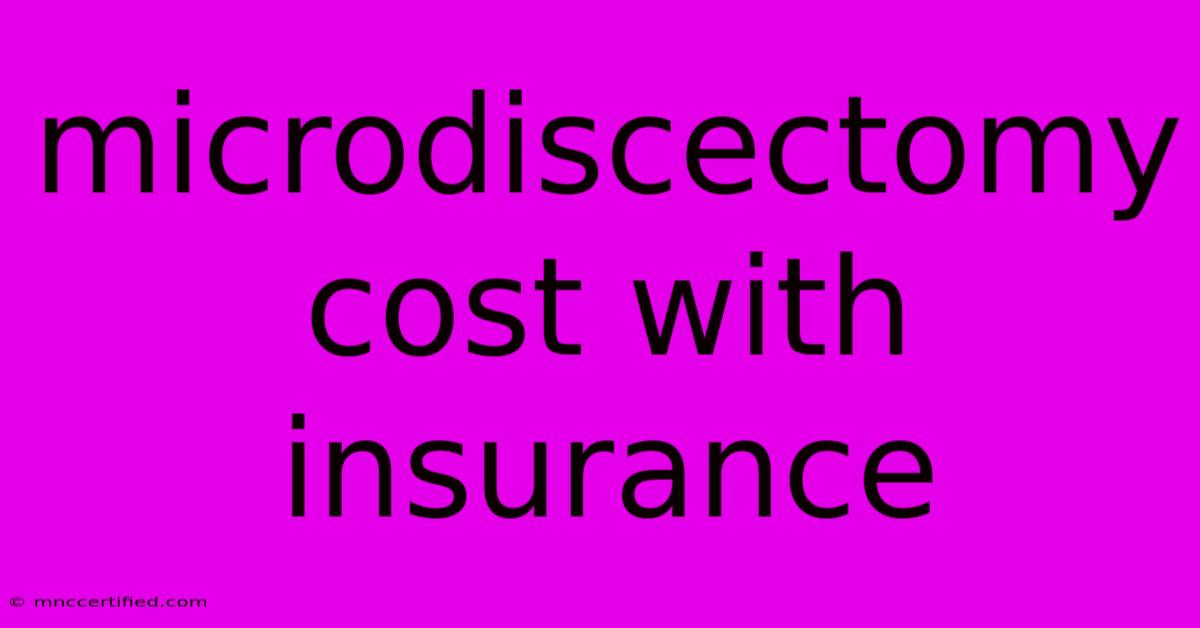Microdiscectomy Cost With Insurance

Table of Contents
Decoding the Cost of Microdiscectomy: What Your Insurance Might Cover
Experiencing debilitating back pain can be a major disruption to your life. If conservative treatments like physical therapy and medication haven't provided relief, you might be considering surgery. Microdiscectomy, a minimally invasive procedure to remove a herniated disc fragment, offers a potential path to pain relief. But a crucial question arises: how much will this procedure cost, and what will my insurance cover?
This article breaks down the costs associated with microdiscectomy, explores factors influencing the final price tag, and guides you through understanding your insurance coverage.
Understanding the Breakdown: Factors Affecting Microdiscectomy Costs
The cost of microdiscectomy can vary considerably depending on various factors. Here's a closer look at the key influences:
1. Location and Facility:
- Hospital vs. Ambulatory Surgical Center: Procedures conducted in hospitals generally come with higher costs due to the overhead associated with operating rooms and specialized equipment.
- Geographic Location: Costs can differ significantly based on the region's cost of living and the competitive landscape of medical providers.
2. Surgeon's Fees:
- Experience and Reputation: Surgeons with extensive experience and a strong reputation may charge higher fees.
- Complexity of the Procedure: The complexity of the surgery, such as the location of the herniated disc, can impact the surgeon's fee.
3. Anesthesia and Operating Room Costs:
- Type of Anesthesia: General anesthesia is typically more expensive than regional anesthesia.
- Operating Room Time: Longer procedures necessitate more time in the operating room, leading to higher costs.
4. Post-Operative Care:
- Hospital Stay: If an overnight stay is required, this adds to the overall cost.
- Rehabilitation: Physical therapy and other rehabilitation services needed after surgery contribute to the total expenses.
Insurance Coverage: Navigating the Maze
Insurance coverage for microdiscectomy can vary depending on your specific plan. Here's a breakdown of what you should know:
1. Understanding Your Plan:
- Deductible: You'll likely have a deductible to meet before your insurance starts covering costs.
- Co-insurance: Your insurance may require you to pay a percentage of the covered costs, known as co-insurance.
- Out-of-Pocket Maximum: There's often a limit on the maximum amount you'll pay out of pocket for medical expenses in a year.
2. Pre-Authorization:
- Necessary for Coverage: Most insurance plans require pre-authorization for surgery, which means getting approval from your insurance company before the procedure.
- Documentation Required: Provide your insurance company with relevant medical records and information about your condition to support the need for surgery.
3. Negotiation and Cost Transparency:
- Ask for Cost Estimates: Don't hesitate to inquire about estimated costs for the procedure and related services before you commit.
- Seek Negotiated Rates: Many hospitals and surgical centers offer negotiated rates for self-pay patients.
Tips for Minimizing Costs:
- Shop Around: Compare costs and coverage across different hospitals and surgical centers.
- Consider Ambulatory Surgical Centers: These facilities often offer lower costs than hospitals.
- Explore Payment Plans: Inquire about payment plans or financing options offered by the medical provider.
- Advocate for Yourself: Don't be afraid to ask questions and advocate for your best interests regarding costs and insurance coverage.
Remember: This article provides general information about microdiscectomy costs and insurance coverage. It's essential to consult with your insurance provider and your surgeon for specific details about your situation.
Key Takeaway: Microdiscectomy costs can vary significantly, but understanding the factors influencing the price tag and navigating your insurance coverage can empower you to make informed decisions about your treatment. By taking the time to research and communicate clearly with your provider and insurer, you can potentially minimize your financial burden while pursuing the relief you need.

Thank you for visiting our website wich cover about Microdiscectomy Cost With Insurance. We hope the information provided has been useful to you. Feel free to contact us if you have any questions or need further assistance. See you next time and dont miss to bookmark.
Featured Posts
-
Sonnenberg Mutual Insurance Company
Nov 13, 2024
-
I M A Celebrity 2024 Full Lineup Confirmed
Nov 13, 2024
-
Constitution Life Insurance Company
Nov 13, 2024
-
Hegseth From Fox News To Defense Secretary
Nov 13, 2024
-
Seismic Activity 2 4 Magnitude Earthquake Near Akutan
Nov 13, 2024